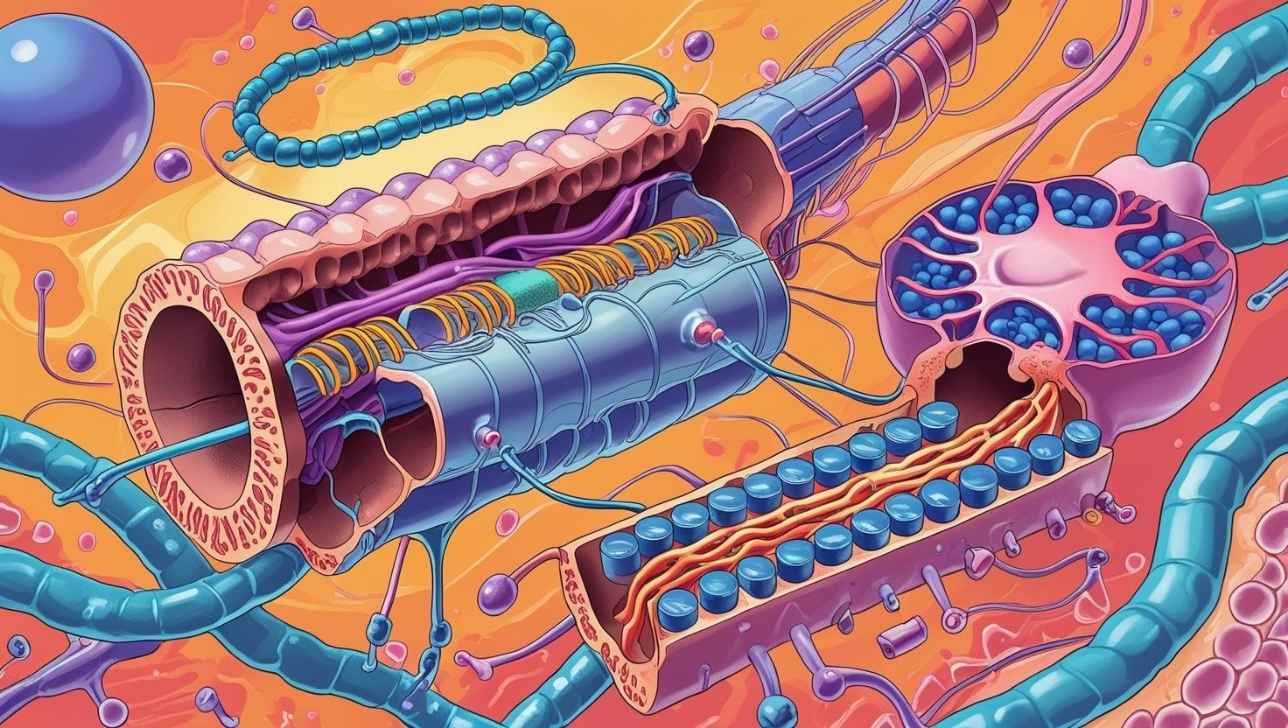The Role of Mitochondria in Energy Production and Cell Function
Mitochondria are often referred to as the powerhouses of the cell because of their crucial role in energy production. These tiny organelles are found in almost every cell in your body and are responsible for generating the energy that cells need to function. This process, known as cellular respiration, involves breaking down nutrients to produce adenosine triphosphate (ATP), the primary energy currency of the cell.
Let’s dive into how mitochondria contribute to energy production and cell function, and why they are so essential for our overall health and well-being.
Structure of Mitochondria
The structure of mitochondria is uniquely suited to its function. Each mitochondrion is enclosed by two membranes: an outer membrane and an inner membrane. The outer membrane is smooth and allows small molecules to pass through freely. The inner membrane is highly folded, forming structures called cristae, which increase the surface area and thus enhance the efficiency of energy production.
Inside the mitochondria, there is also a matrix where many of the enzymes involved in energy production reside. This internal space is vital for the chemical reactions that convert food into energy.
Key Components Involved in Energy Production
To understand how mitochondria produce energy, it’s helpful to look at the key components involved:
- Citric Acid Cycle (Krebs Cycle): Occurs in the mitochondrial matrix and involves a series of chemical reactions that generate ATP and electron carriers like NADH and FADH2.
- Oxidative Phosphorylation: Takes place in the inner mitochondrial membrane. It uses the electrons from NADH and FADH2 to create a proton gradient, which drives the synthesis of ATP through a process called chemiosmosis.
| Component | Function |
|---|---|
| Cristae | Increase surface area for more efficient energy production |
| Matrix | Contains enzymes necessary for the citric acid cycle |
| Inner Membrane | Site of oxidative phosphorylation and ATP synthesis |
Role in Cell Function Beyond Energy Production
While producing energy is the most recognized function of mitochondria, they play several other critical roles in cell function:
- Calcium Storage: Mitochondria help regulate calcium levels within the cell, which is crucial for various signaling pathways.
- Apoptosis: They are involved in programmed cell death, helping to eliminate damaged or unwanted cells.
- Thermogenesis: In certain tissues like brown fat, mitochondria can generate heat by burning fat, which is important for maintaining body temperature.
Impact on Health and Disease
The health of mitochondria has significant implications for overall health. Dysfunction in mitochondrial processes can lead to a range of diseases, including:
- Mitochondrial Diseases: These are genetic disorders that affect mitochondrial function, leading to problems with energy production and potentially affecting multiple organ systems.
- Neurodegenerative Diseases: Conditions like Alzheimer’s and Parkinson’s disease are associated with mitochondrial dysfunction, which can impair nerve cell function.
- Cardiovascular Diseases: Mitochondrial issues can contribute to heart conditions by affecting the heart muscle’s ability to produce energy efficiently.
Nutrition and Lifestyle Factors
Given the importance of mitochondria in health, it’s crucial to consider how nutrition and lifestyle can support mitochondrial function:
- Diet: Consuming foods rich in antioxidants, such as fruits and vegetables, can help protect mitochondria from damage.
- Exercise: Regular physical activity promotes the formation of new mitochondria and improves their efficiency.
- Supplements: Certain supplements, like Coenzyme Q10 (CoQ10) and L-carnitine, may support mitochondrial health.
Mitochondria are indispensable for energy production and play a multifaceted role in cell function. Their structure and the processes they facilitate are intricately linked to the health and survival of cells. Understanding these roles can help us appreciate the significance of maintaining mitochondrial health through diet, exercise, and lifestyle choices. By supporting mitochondrial function, we can enhance our overall health and potentially mitigate the risks of various diseases.
Mitochondrial Dysfunction and Its Impact on Human Health
Mitochondria are often referred to as the powerhouses of the cell because they generate most of the energy that cells need to function. They play a critical role in maintaining overall health, but when these organelles malfunction, it can lead to various health issues. Mitochondrial dysfunction refers to the failure of mitochondria to perform their normal functions effectively. This dysfunction can arise due to genetic mutations, environmental factors, or aging, leading to a range of symptoms and diseases.
One of the primary functions of mitochondria is producing adenosine triphosphate (ATP), which is the energy currency of the cell. ATP is generated through a process called oxidative phosphorylation, which occurs in the inner membrane of the mitochondria. When mitochondria fail to produce sufficient ATP, cells struggle to carry out essential tasks, leading to a variety of symptoms. For instance, muscle weakness, fatigue, and cognitive decline are common manifestations of mitochondrial dysfunction.
Types of Mitochondrial Diseases
Mitochondrial dysfunction can result in a spectrum of disorders known collectively as mitochondrial diseases. These diseases can affect multiple systems of the body, including the brain, muscles, heart, liver, kidneys, and endocrine system. Some common types of mitochondrial diseases include:
- MELAS Syndrome (Mitochondrial Encephalomyopathy, Lactic Acidosis, and Stroke-like episodes): Characterized by stroke-like episodes, seizures, and muscle weakness.
- MERRF Syndrome (Myoclonic Epilepsy with Ragged Red Fibers): Associated with myoclonus (muscle jerks) and epilepsy.
- Kearns-Sayre Syndrome (KSS): Involves eye muscle paralysis, cardiac conduction defects, and pigmentary retinopathy.
Symptoms and Diagnosis
The symptoms of mitochondrial dysfunction can vary widely depending on the affected organs and tissues. Common symptoms include:
- Chronic fatigue
- Muscle weakness and exercise intolerance
- Cardiac issues like arrhythmias
- Neurological problems such as seizures and cognitive decline
- Visual and hearing impairments
Diagnosing mitochondrial diseases typically involves a combination of clinical evaluation, laboratory tests, and imaging studies. Blood tests can measure lactic acid levels, which are often elevated in mitochondrial disorders. Genetic testing may also be used to identify mutations in mitochondrial DNA or nuclear DNA that affect mitochondrial function.
Treatment and Management
Currently, there is no cure for mitochondrial diseases, but treatments aim to manage symptoms and improve quality of life. These treatments can include:
- Dietary interventions: Such as a ketogenic diet, which provides high-fat, low-carbohydrate meals to help the body produce more ATP.
- Vitamin and supplement therapy: Coenzyme Q10, L-carnitine, and B vitamins are commonly used to support mitochondrial function.
- Physical therapy: To maintain muscle strength and mobility.
- Medication: To address specific symptoms such as seizures or cardiac issues.
Supportive care, including regular monitoring and lifestyle adjustments, is crucial for managing mitochondrial dysfunction.
Prevention and Future Directions
Given the complexity of mitochondrial diseases, prevention remains challenging. However, research continues to uncover new insights into the mechanisms underlying mitochondrial dysfunction. Advances in gene therapy and stem cell technology offer potential future treatments. Additionally, early detection and intervention can significantly improve outcomes for individuals affected by mitochondrial diseases.
Mitochondrial dysfunction has far-reaching implications for human health, affecting multiple bodily systems. Understanding its causes, symptoms, and management options is crucial for developing effective treatment strategies and improving the lives of those affected. Continued research and advancements in medical science hold promise for better prevention and treatment in the future.
Conclusion
Understanding the vital role of mitochondria in energy production and cell function is crucial for grasping how our bodies operate at a fundamental level. These powerhouses convert nutrients into ATP, the energy currency of cells, enabling us to perform daily activities and maintain overall health. However, when mitochondrial dysfunction occurs, it can lead to a cascade of issues affecting various aspects of our well-being. From neurological disorders to metabolic diseases, the impact of compromised mitochondrial function underscores the importance of maintaining their health. By adopting a balanced diet rich in antioxidants and engaging in regular physical activity, we can support mitochondrial health and potentially mitigate the risks associated with dysfunction. As research continues to uncover new insights, staying informed about mitochondrial function can empower us to make choices that promote longevity and vitality.


